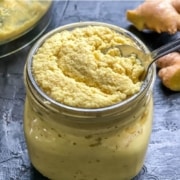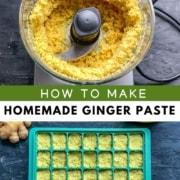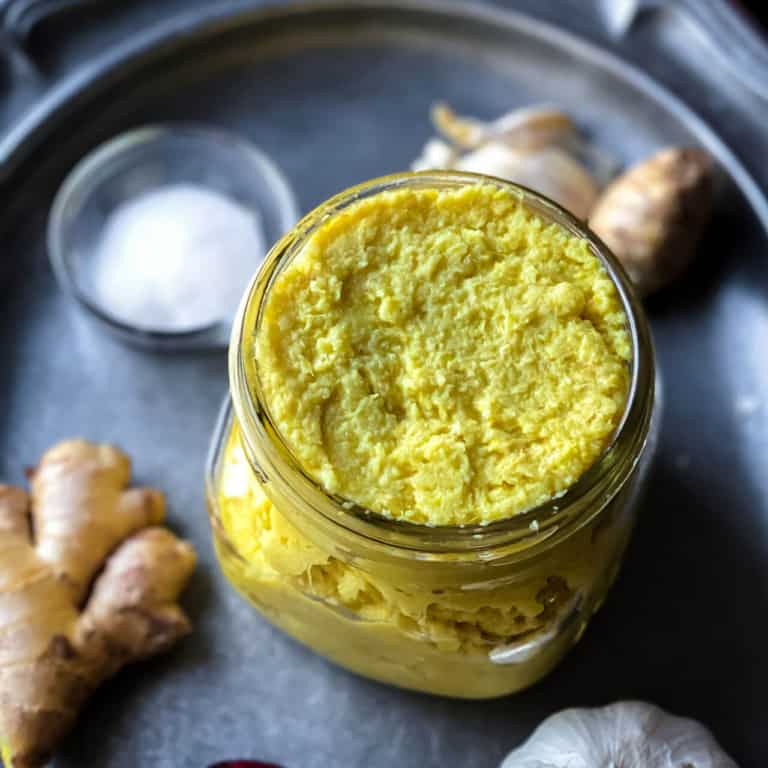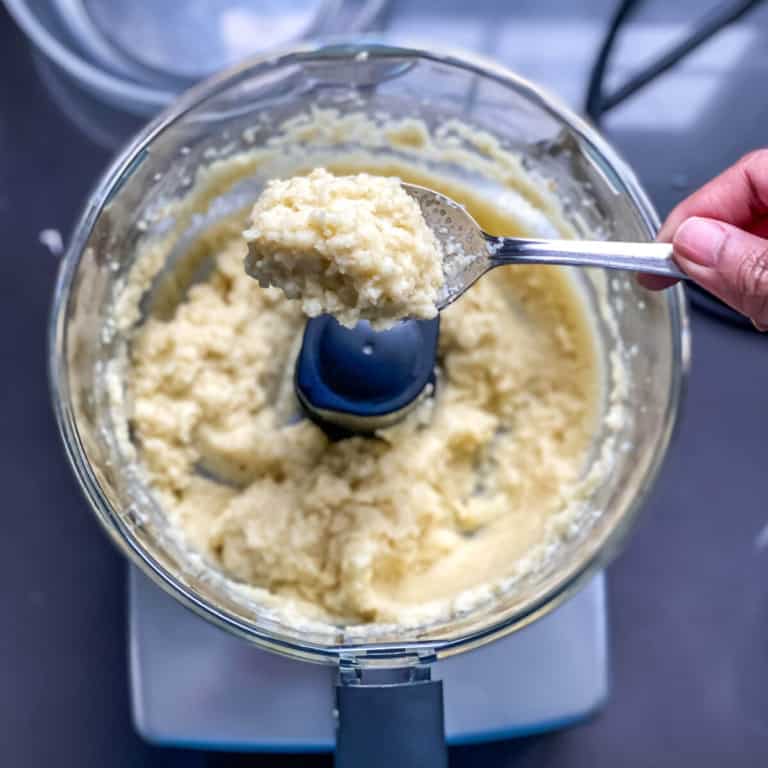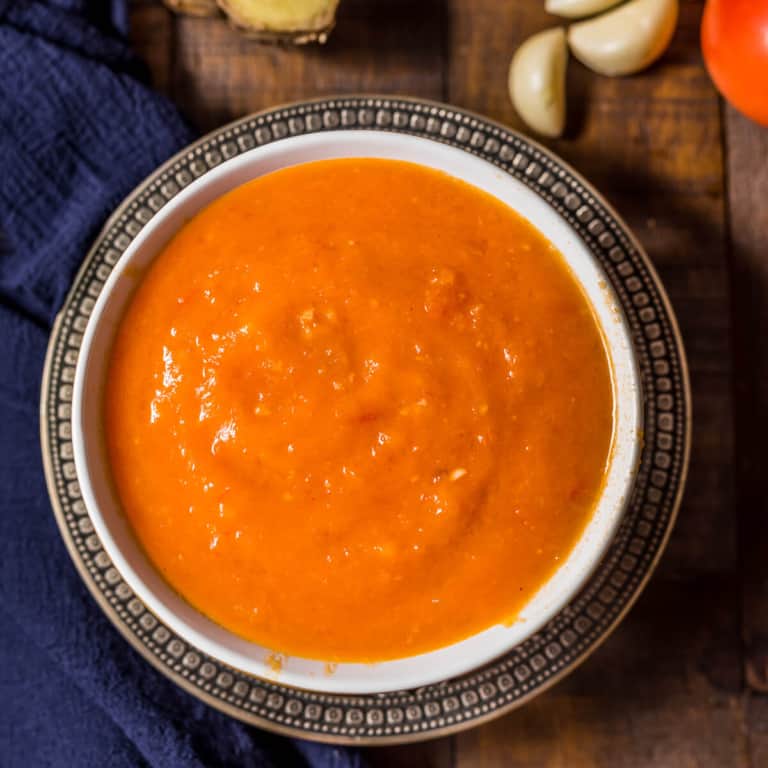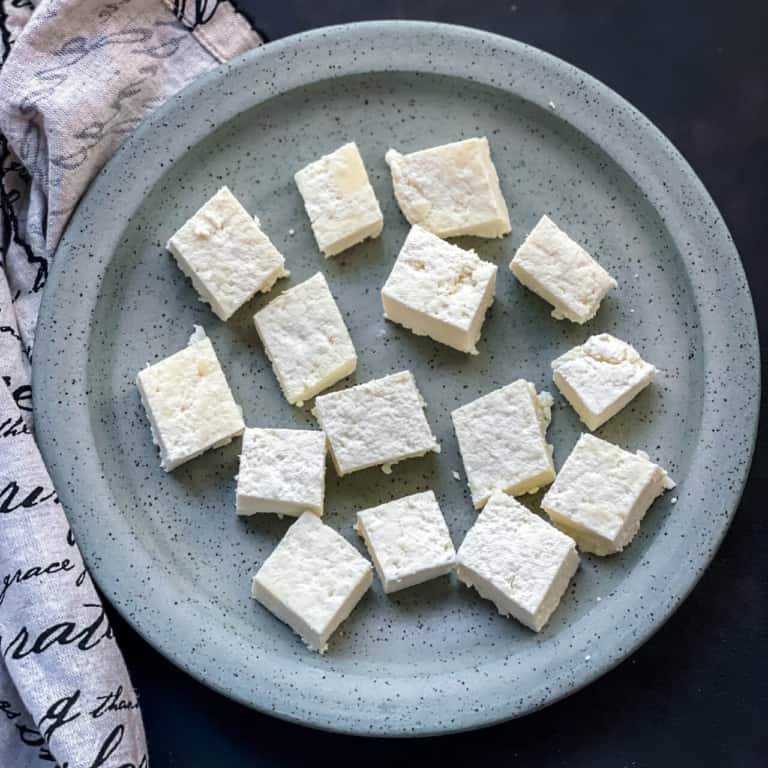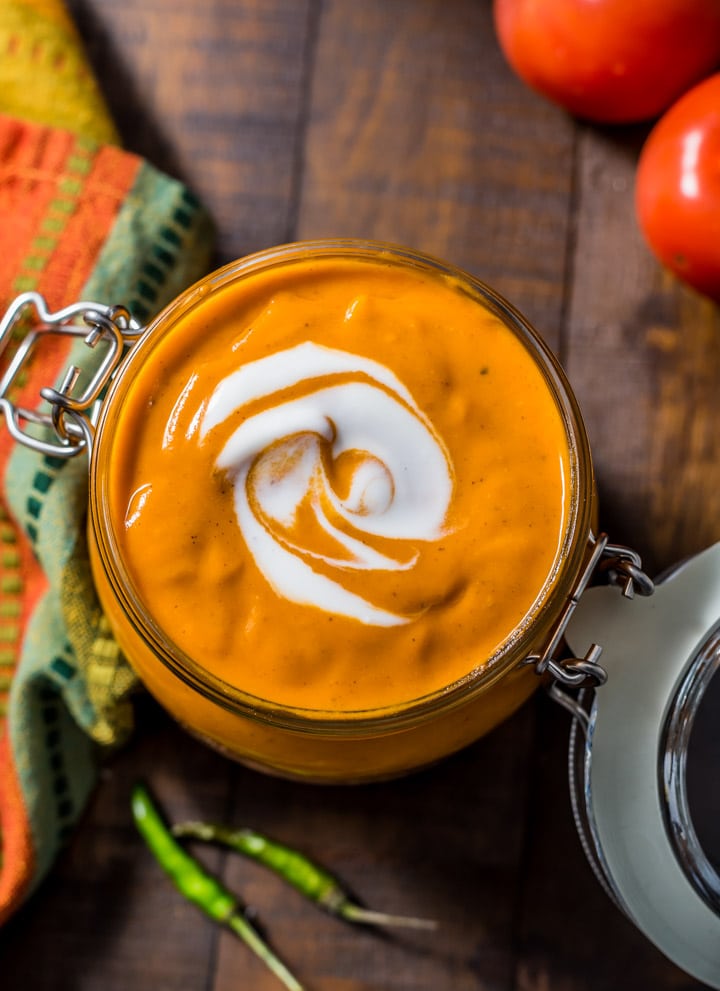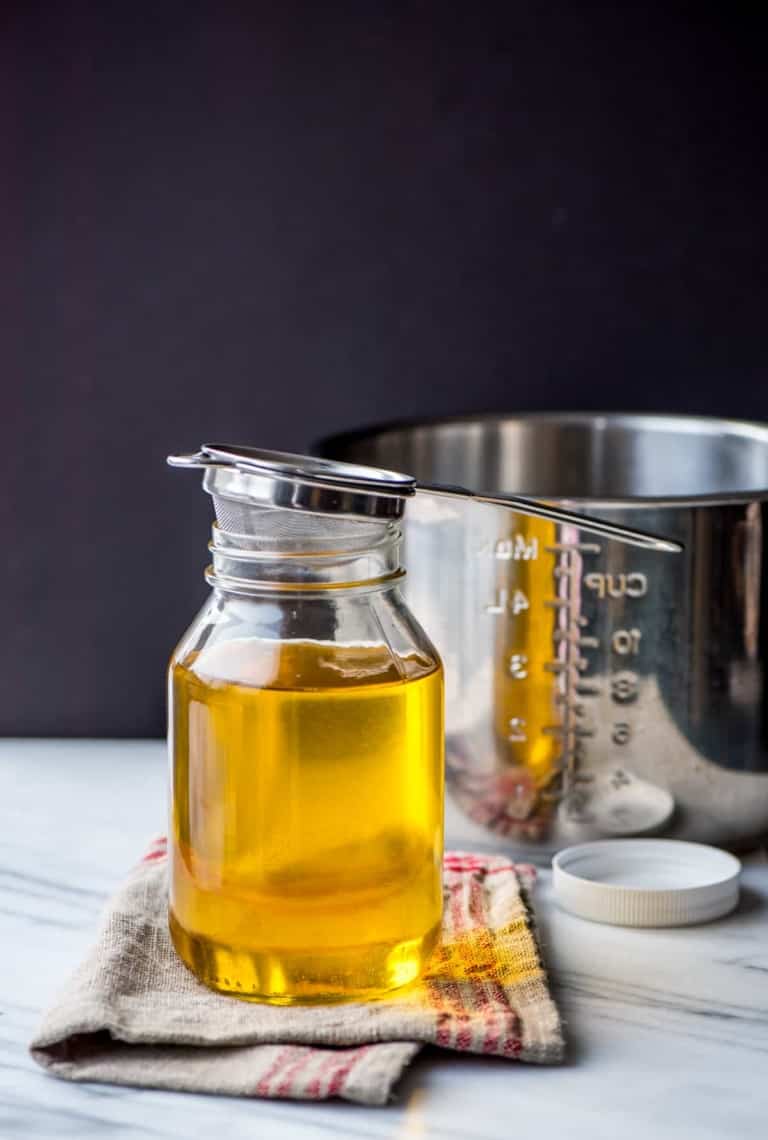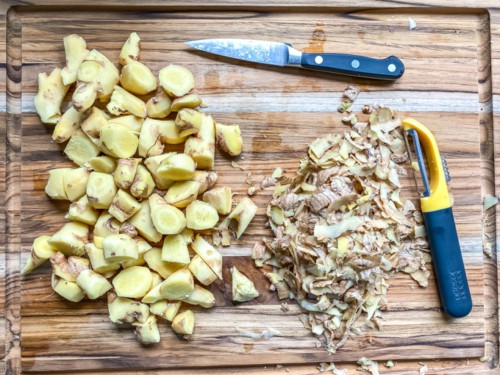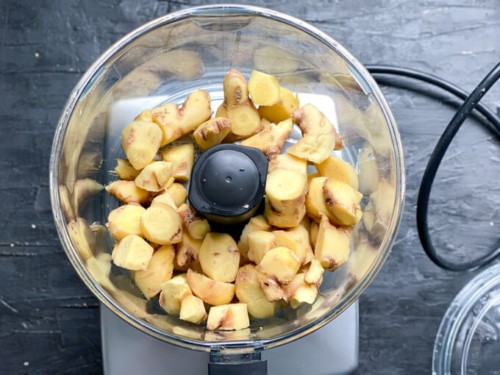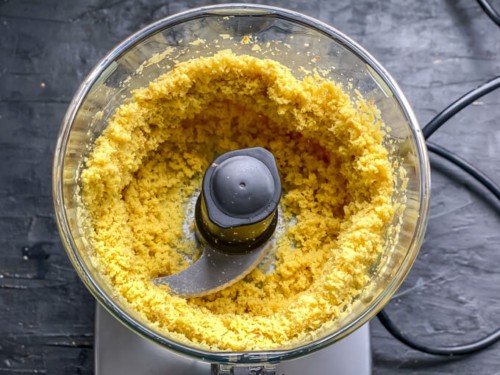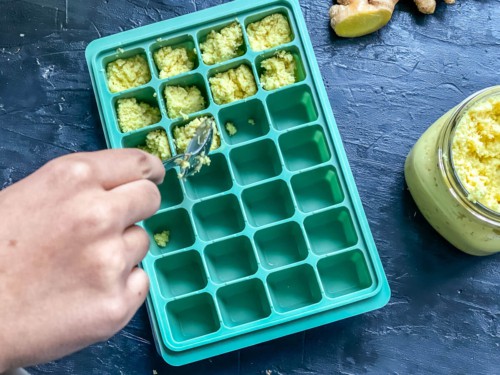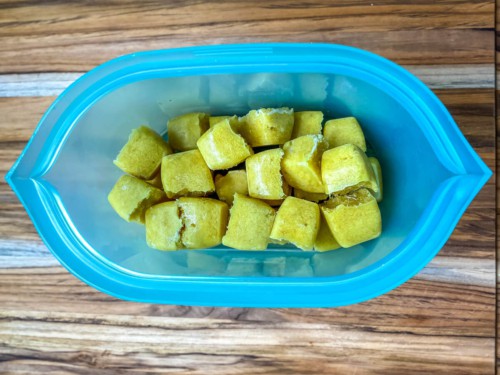How to make Ginger paste
Note: This post contains affiliate links. As an Amazon Associate I earn from qualifying purchases.
If you’re looking for a simple meal prep alternative to freshly minced ginger, you’re going to love this easy recipe for homemade ginger paste or puree.
Made with just 2 ingredients, it’s a simple way to always make sure you have fresh ginger on hand. Stores for up to 6 months in the freezer!
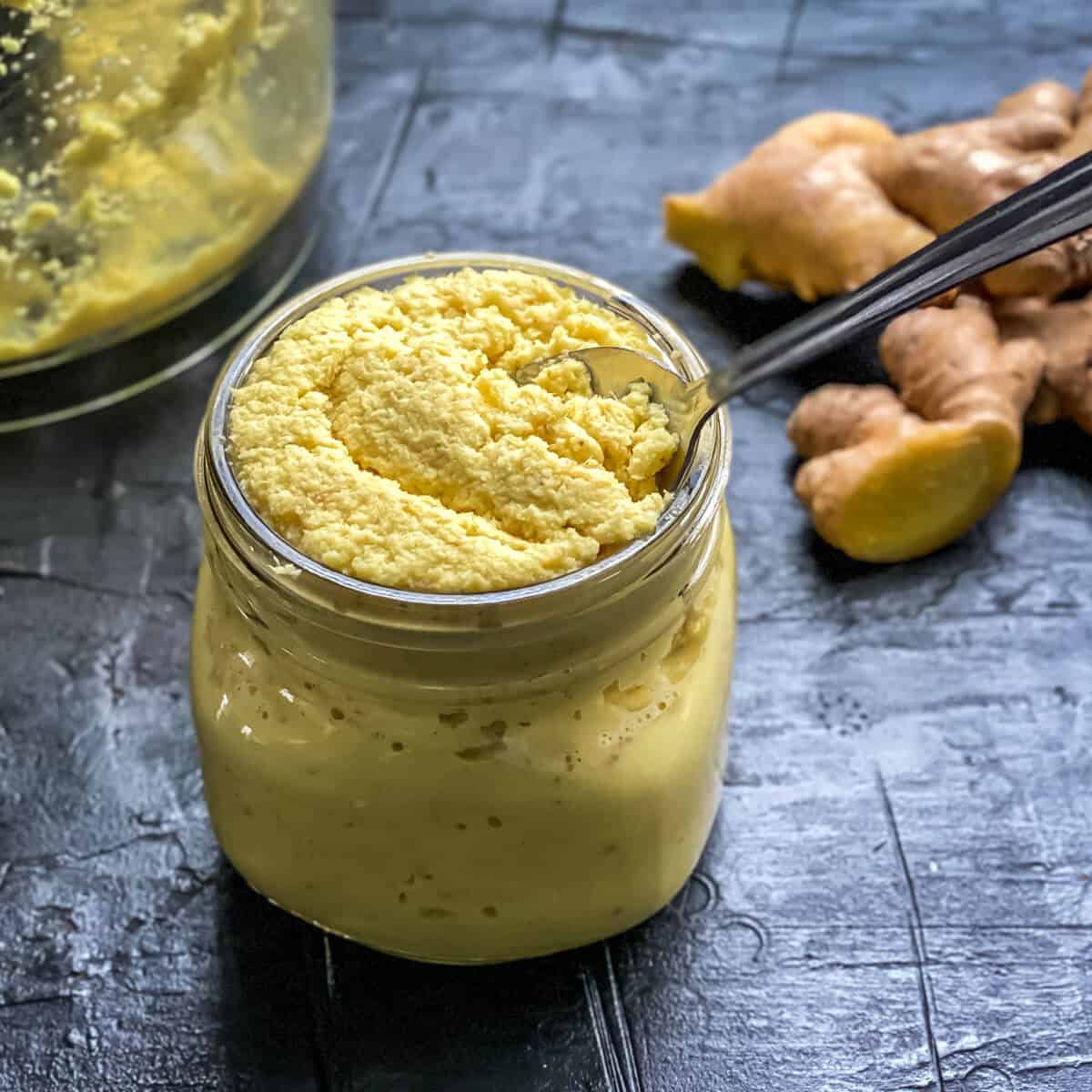
My family loves eating freshly cooked meals daily. In order to find time to make the dishes they love, I’ve learned a few time-saving meal prepping tricks and shortcuts to make preparing our favorite meals a little bit easier.
One of those shortcuts is making ginger paste at home.
Using this homemade ginger paste in my kitchen saves me a few minutes per meal, and those minutes really add up! Especially when paired with other time-saving meal prep recipes like my ginger-garlic paste, garlic paste, and bhuna masala.
Using ginger paste gives you all of the flavors of fresh ginger root, without all of the peeling, chopping, and grating.
This essential ingredient is a staple in many cuisines, particularly Indian food and Asian recipes. It’s surprisingly easy to make, and the spicy ginger flavor it adds to dishes is incomparable to store-bought ginger paste.
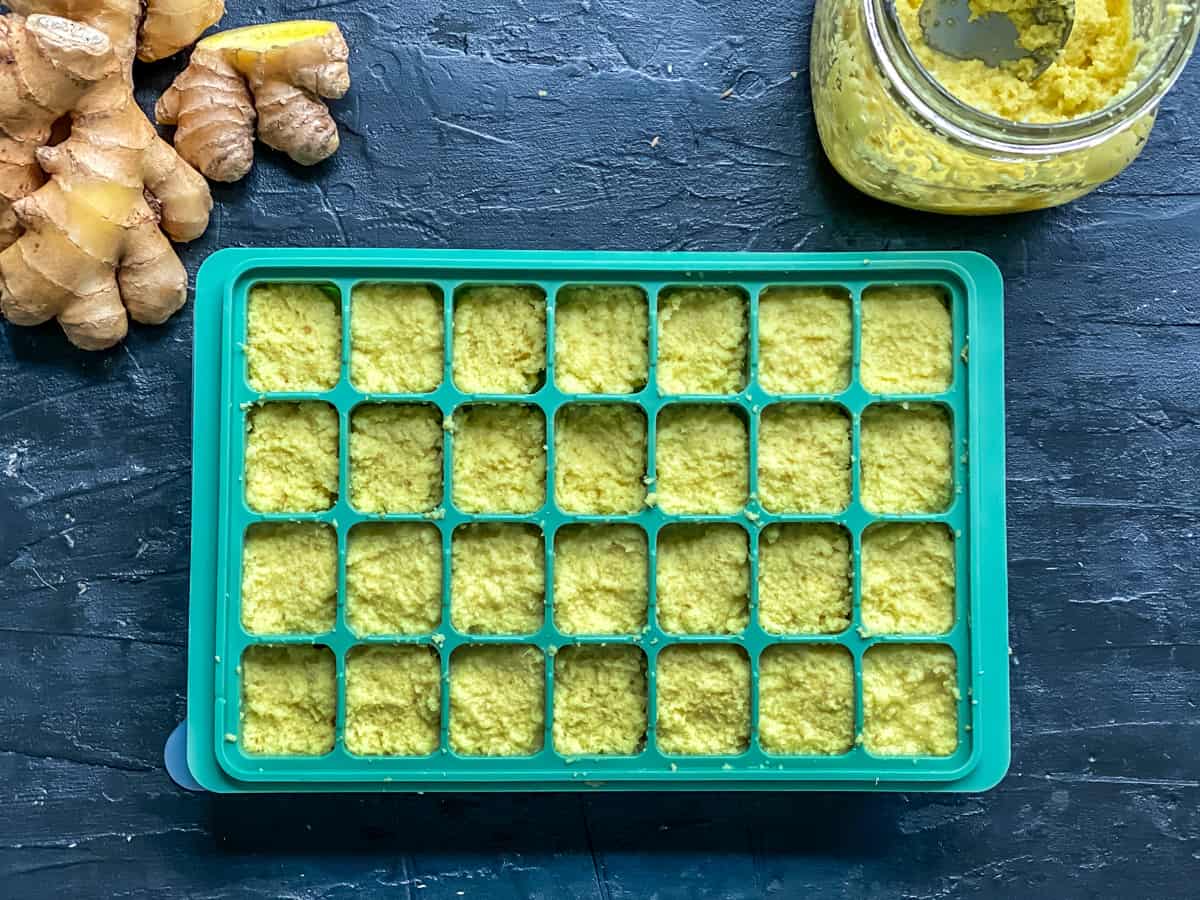
What is ginger paste?
Fresh ginger paste is made by blending chopped (and sometimes peeled) ginger into a fine paste. It often uses water or oil in the process to create a smooth consistency. It has a strong flavor that is identical to that of fresh ginger and can be preserved for up to 6 months when stored in the freezer.
The ginger paste can be used as a fresh ginger substitute and has a very fine texture. It is perfect for tea, curries, and sauces.
Benefits
Fresh ginger has been used medicinally for centuries and continues to be used to treat a variety of conditions and ailments. Ginger is loaded with antioxidants and is considered anti-inflammatory. It is also used to treat nausea and has also been shown to lower both cholesterol and blood pressure levels.
Read more: 11 Health Benefits of Ginger
Ginger and its forms
Ginger is a very common ingredient in Indian cooking and is used in a great variety of cuisines all over the world. While it is most often used fresh, there are several different forms available that make getting a delicious ginger flavor very easy.
Puree – Pureed ginger (also known as ginger paste) is made by blending or grinding fresh peeled ginger into a fine puree. Some water (or occasionally oil) is used to create a smooth consistency.
Ground – This is ginger that has been dried or dehydrated and ground to a fine powder. This is most often found in the spices and seasoning section of the grocery store, but it can also be found in the bulk foods section.
Minced – Minced ginger is sold in jars, and is a bit coarser in consistency when compared to pureed ginger/ginger paste. It resembles the same texture as jarred minced garlic and often has oil or preservatives added to give it a longer shelf life.
Grated – Use a handheld grater or cheese grater to grate ginger. Add it to tea or any recipe that calls for ginger puree or paste.
Substituting fresh ginger
Ginger comes in various forms, and here’s how you can substitute one for the other.
- 1-inch ginger piece = 1 tablespoon of fresh ginger paste
- 1-inch ginger piece = 1 tablespoon minced / grated ginger
- 1-inch ginger piece = 1 teaspoon ground ginger powder
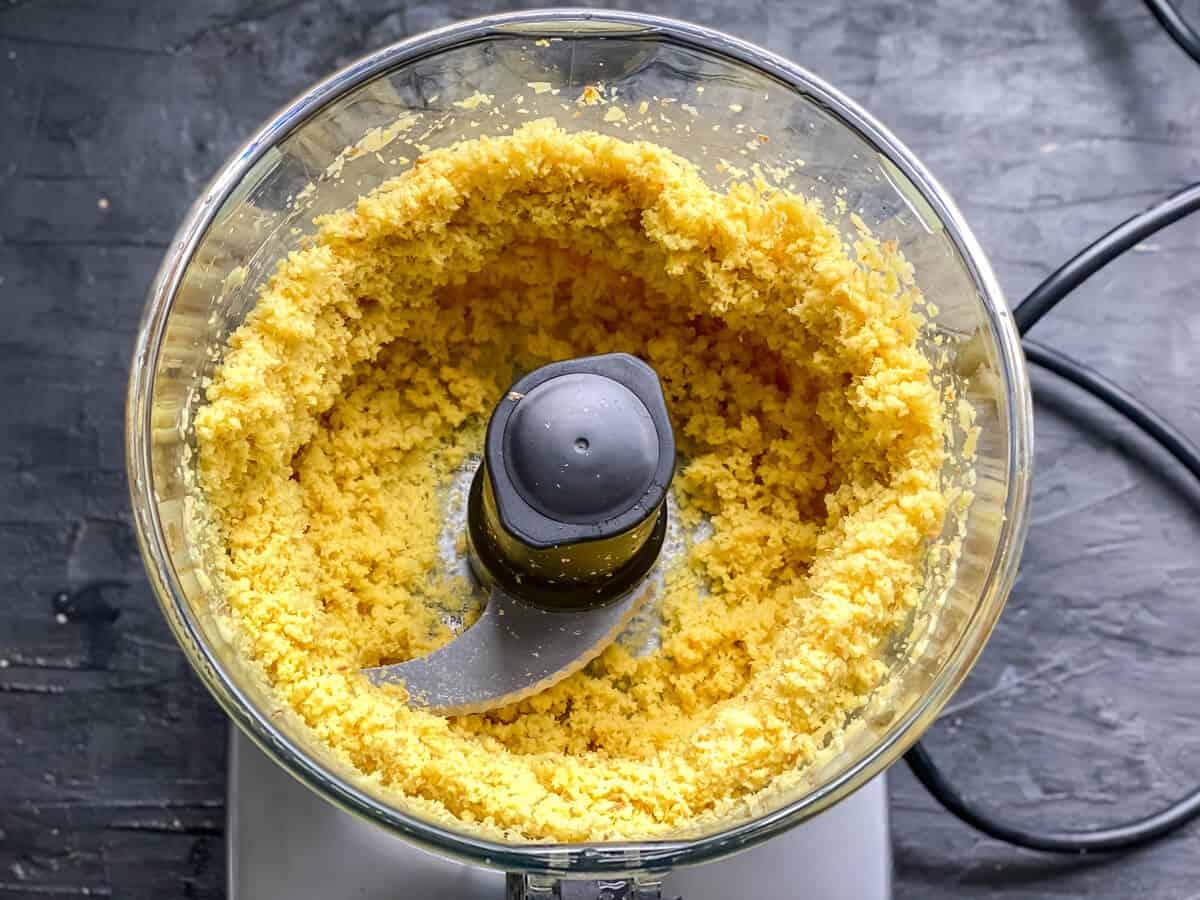
Where to buy ginger and ginger paste
Ginger, in all of its forms, can be purchased from most large grocery chains and supermarkets. Fresh ginger will be found in the produce section, while minced ginger and ground ginger will be found in the spices and seasonings aisle.
You can usually find ginger paste in Indian stores, but they do have preservatives and additives to make them shelf-stable.
Reasons to make ginger paste at home
- More fresh and flavorful than storebought.
- It is much cheaper than store-bought too!
- When you make your ginger paste from scratch, you can make sure there are no additives or preservatives. The same can’t be said for most store-bought versions.
- Prepping ginger paste in advance is a meal prep hack! No need to thaw; you can add the frozen cubes directly to your meal. This saves so much time, without compromising flavor.
Here’s what you need to make ginger paste
Ingredient notes/swaps
- Ginger – You can leave organic ginger unpeeled. Scrub the ginger off any dirt and rinse with water before using it.
- Oil or water for a smoother puree – I prefer using water so that it can be used in smoothies and teas. If using oil, pick any neutral oil such as avocado or sunflower oil.
- Salt – if refrigerating the paste. I freeze the paste I make at home, so I skip it. Salt acts as a natural preservative along with oil and helps increase the shelf life.
Be sure to check out the full recipe and ingredient list below.
How to pick ginger
When making homemade ginger paste, choosing the right fresh ginger root is crucial. Opt for organic ginger if available; it’s known for its strong flavor and pungent flavor.
Select ginger roots with thin skin that are smooth, firm, and without wrinkling or blemish. Be on the lookout for sunken sections or dark spots, as those indicate improper storage and spoilage.
Fresh, high-quality ginger should have a pleasant smell and be firm without being hard and woody.
Should you peel ginger before using it?
If you are purchasing young ginger with very thin skin, you often will not need to peel it. Older ginger, or ginger that has been shipped and stored for a longer period of time will require you to peel the toughened skin. It’s also a good idea to peel your ginger if it is not organic, as any sprays may be residual on the skin.
Organic ginger can be left unpeeled, but just be sure to rinse and scrub the ginger to remove any loose dirt and ensure it is cleaned well. Note: Leaving the peels on can give it a grainy or rough texture.
How to peel ginger
The easiest way to peel ginger is by cutting the root into manageable pieces and using a vegetable peeler. Since ginger roots can have odd shapes, cutting them into sections can help simplify the peeling process.
Pull the peeler towards you, running it under the skin of the ginger. If there are small pieces of peel left in the nooks and crannies of the ginger root, you can use a paring knife to remove them or leave them if the skin is very thin.
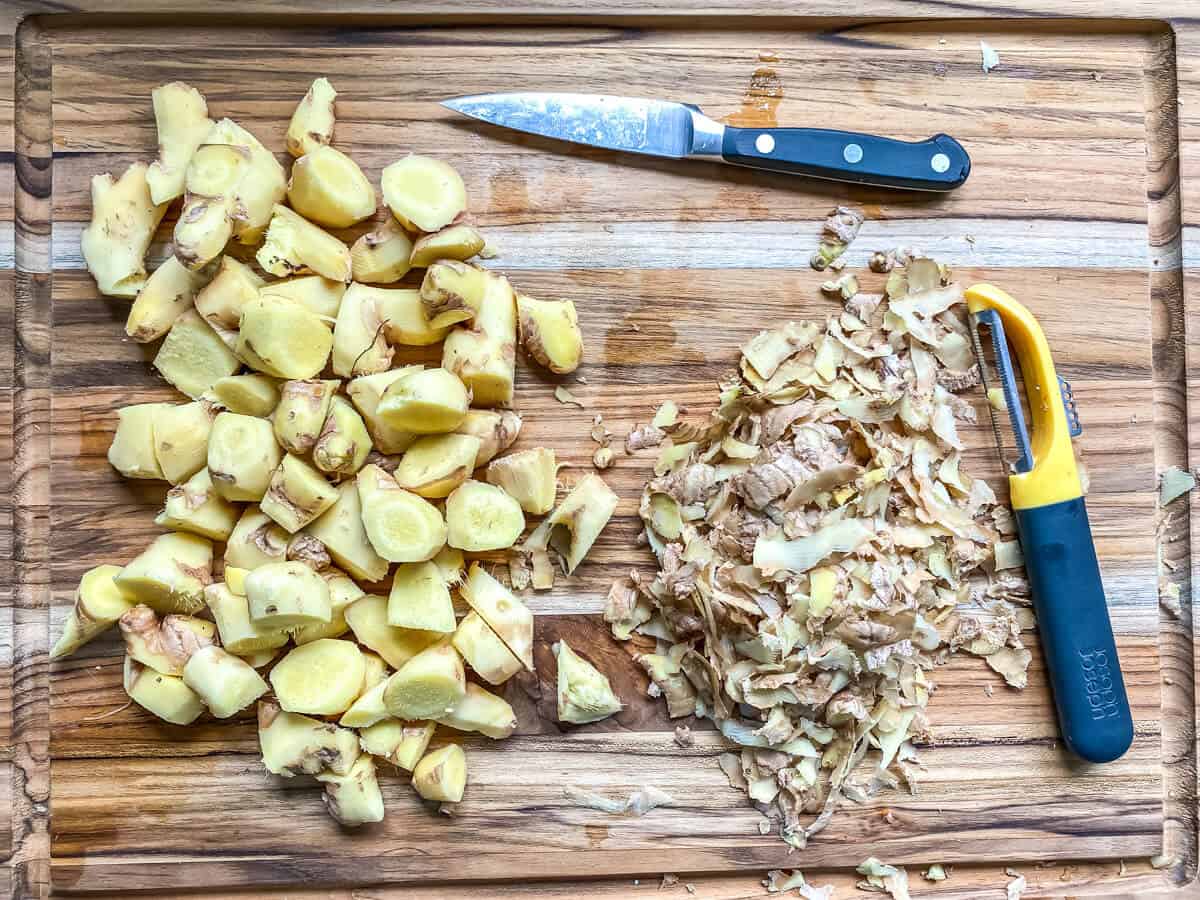
Tools needed
You’ll need a food processor or a high-speed blender to make a smooth paste.
- Vegetable peeler
- Mortar / pestle – if you prefer to make it the old-school way.
- Blender or food processor
- Silicone ice-cube tray – for freezing the paste.
- Reusable storage bag or Ziplock – To store frozen ginger cubes.
TIPS
- Buy the best quality ginger available – pick ones that are free of blemishes and wrinkles and with shiny skin.
- If using organic ginger, feel free to leave the peels on. Rinse the ginger and scrub it clean before using it.
- When scooping out the refrigerated ginger paste, always use a clean and dry spoon to prevent the ginger paste from going bad quickly.
- Do not thaw the frozen cubes. Remove the quantity needed and immediately put the remaining cubes back in the freezer.
- Instead of water, use oil to make the paste. The oil acts as a preservative and increases the shelf life of the paste. Adding water while making the paste may cause water to spit when frying and reduce shelf life.
- If you are going to use ginger paste to make tea, blend it with water instead of oil.
- You can skip both oil and water, but your ginger paste will be a little chunky.
Storage tips
Follow the steps below to preserve the homemade ginger paste
- Store in the refrigerator in an air-tight container for about 7-10 days. I love to use glass containers because the gingery smell is easier to rinse off.
- To preserve for 3-4 months, transfer the ginger paste to an ice tray (preferably with a lid to avoid freezer burn), leaving some space for expansion.
- Once frozen (will take about 6-8 hours), transfer it to a Ziploc or a reusable storage bag and store it in the freezer for up to 6 months.
I use this silicone ice-cube tray to freeze the paste. It has a capacity for about two teaspoons per crevice, but I fill around 1.5 teaspoons to allow the paste to expand.
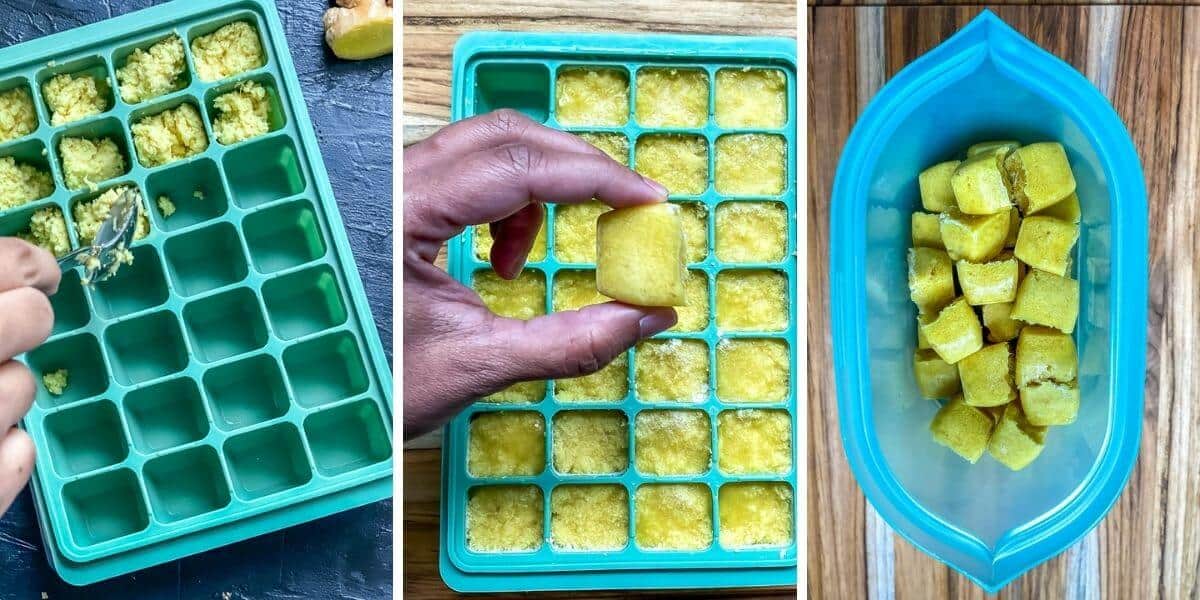
How to use
You can use ginger paste in smoothies, ginger tea, curries, soups, or any recipe that calls for grated/minced ginger.
When replacing fresh ginger with ground ginger, remember that 1-inch knob of ginger = 1 tablespoon of paste.
Depending on how you have stored the paste (refrigerator or freezer), there are two ways to use the paste –
- Refrigerated paste: Replace a 1-inch knob of ginger with one tablespoon of paste.
- Frozen cubes: I use this silicone ice-cube tray to freeze the paste. It has a capacity for about two teaspoons per mold, but I recommend you fill around 1.5 teaspoons to allow the paste to expand. For most recipes, one cube of ginger should be sufficient. No need to thaw before using.
Important: While using in curries, always saute the ginger in oil for a minute or two so that the raw taste disappears. You don’t want your food to taste super gingery!
Indian recipes that use ginger
Many Indian recipes call for and use fresh ginger. Here are a few of my favorite ways to use ginger:
- Use it to make this refreshing cup of ginger tea.
- Or in this finger-licking cilantro mint chutney that pairs well with literally everything.
- This cooling curd rice is perfect for the summer.
- Or this restaurant-style tandoori chicken marinade.
Ginger paste substitute
If your recipe calls for ginger paste and you don’t have any on hand, there are a few easy substitutes you can use instead. For each tablespoon of ginger paste, you can use 1 inch of fresh ginger in its place, 1 tablespoon of minced ginger, or 1 teaspoon of ground or powdered ginger.

Frequently asked questions
You can use ginger paste for tea if you have made the paste with water and not oil.
Ginger paste is used to replace fresh ginger in any of your favorite recipes, including curries, teas, sauces, marinades, and dressings. 1 tablespoon of ginger paste replaces approximately 1 inch of fresh ginger.
You can, although it will require some elbow grease. Add thinly sliced ginger to a mortar and pound it with a pestle to crush the ginger into a paste. Work in small batches for best results.
1 tablespoon of ground ginger is equal to approximately 1 inch of fresh ginger.
Ginger paste is an excellent substitute for fresh ginger, and if it is frozen and preserved properly, it tastes just as flavorful as fresh ginger. It’s important to store it properly to preserve the flavor and minimize freezer burn.
Since the homemade ginger paste is a fresh product and contains no preservatives, it can spoil if not properly stored. If stored in the refrigerator, it will last for 7-10 days. For longer storage, freeze in cubes and add to a freezer bag. Store in the freezer for up to 6 months.
More Meal Prep Recipes
Making homemade ginger paste is totally worth the effort. With its strong flavor and numerous health benefits, it’s a fantastic addition to any meal. For times when you need both ginger and garlic in your meals, try this homemade ginger garlic paste – it is a huge timesaver!
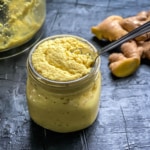
How To Make Homemade Ginger Paste
Equipment
Ingredients
- 1 lb ginger peeled and chopped
- ¾ cup water
Instructions
- Peel and chop the ginger into 1 to 2-inch pieces.

- Add chopped ginger, and water to a blender.

- Grind to a fine paste. Make it in batches, if needed.

Storage Instructions
- Store in the refrigerator in an air-tight glass container for about 7-10 days.
- Transfer the ginger paste to an ice-cube tray, leaving room for expansion.

- Once frozen, pop the cubes out and transfer it to a Ziploc or a silicone bag and store it in the freezer for up to 6 months.

Notes
- Peeling ginger is optional. You can buy organic ginger, give it a good rinse, and use it without peeling. I use this straight peeler because it peels the skin off without taking chunks off the flesh.
- Chop the ginger into small pieces so that it is less work for your blender to puree it.
Disclaimer: Approximate nutritional information is provided as a courtesy and can vary depending on the exact ingredients/brands used. If you have health issues, please work with a registered dietician or nutritionist.
Nutrition
This post was originally written on May 10, 2022, and was republished with additional information on Dec 14, 2023.

